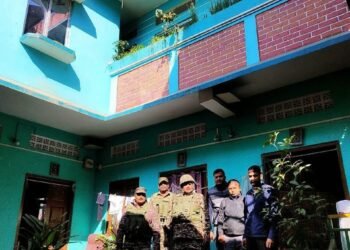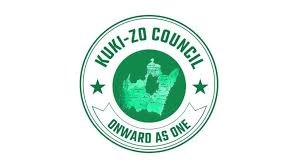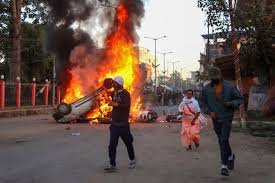Truth Labs’ report—file no. TLH/AV/025/2024—concluded that the Manipur recordings were genuine, continuous, and matched Biren Singh’s voice with high probability. NFSL’s subsequent claim that the same files were “modified” has raised serious doubts
By Navin Upadhyay
New Delhi, November 3, 2025
The controversy surrounding the so-called “Manipur tapes” — purported audio recordings linking former Chief Minister N. Biren Singh to the 2023 ethnic violence — has taken a dramatic twist.
In its sealed report to the Supreme Court, the National Forensic Science Laboratory (NFSL), Gandhinagar has claimed that the tapes were tampered with and “not scientifically fit for voice comparison.”
This new claim, however, stands in stark contradiction to the earlier findings of Truth Labs, an accredited independent forensic agency whose certified report (File No. TLH/AV/025/2024, NABL ULR No. TC14124/25/2004/F9) categorically found that the recordings were continuous, untampered, and contained a voice that matched Singh’s with high probability.
Truth Labs: Tapes Untampered, Voice Match ‘High Probability’
Truth Labs’ report — which was verified and countersigned by Deputy Director A. Ramkumar and Imanuel Premkumar B — delivered clear and unambiguous conclusions:
“The audio video recording marked ‘Q1’ was found to be a continuous recording predominantly containing the voice of one male person… with background noises and voices of other speakers,” the report stated.
“The recordings marked ‘Q2’ to ‘Q4’ were found to be a subset or excerpts of ‘Q1’,” it added.
Most significantly, the laboratory found:
“Based on Auditory, Spectrographic, Statistical and Likelihood analysis… the voice of the speaker in both questioned and standard recordings was identified to be one and the same with high probability.”
Crucially, the Truth Labs report found no evidence of tampering or editing, asserting that the primary file ‘Q1’ was an unedited, continuous recording derived from a preexisting audio source.
Three Labs, Three Stories
The Supreme Court now faces an extraordinary forensic conflict involving three institutions:
- Truth Labs (independent, NABL-accredited): Found recordings continuous and unedited; identified the voice as Biren Singh’s with 93% probability.
- CFSL (Central Forensic Science Laboratory): Declined to authenticate the tape, prompting a rebuke from the Supreme Court on August 19 for misunderstanding the directive — which was to compare voice samples, not to verify authenticity.
- NFSL (National Forensic Science Laboratory): Now says the files were “tampered with” and “unfit for scientific comparison,” effectively invalidating the earlier analyses.
These sharply divergent findings have created a triangular contradiction — with each lab reaching a different conclusion based ostensibly on the same digital evidence.
Manipur Tape: NFSL Says Tapes Tampered — Three Labs, Three Versions https://t.co/BqvFBvH6Ce #ManipurTapes #BirenSingh #NFSLReport#TruthLabFindings #SupremeCourtIndia#ForensicControversy
— POWER CORRIDORS (@power_corridors) November 3, 2025
What Could Have Happened
Forensic experts suggest that the NFSL’s “tampering” conclusion might stem not from actual manipulation of speech content, but from technical reprocessing of the audio files after Truth Labs’ initial analysis.
If the recordings were re-saved, compressed, re-exported, or transcoded — even for procedural submission — their metadata and bitstream continuity would change. That can lead forensic tools to flag modifications or discontinuities even if the spoken content remains identical.
“A simple act of re-saving a file or changing its format can alter metadata timestamps. To a forensic algorithm, that may look like tampering,” explained a senior Delhi-based forensic acoustics analyst.
“The question the Court must ask is — were the words altered, or merely the file properties?”
If NFSL received a reprocessed version of the files — rather than the original forensic copies examined by Truth Labs — its report could reflect data-level alterations rather than content-level manipulation.
READ: Trump Sparks Global Storm, Claims Pakistan Is Testing Nuclear Weapons
Chain of Custody: The Missing Link
The integrity of forensic conclusions depends heavily on maintaining an unbroken chain of custody.
The Supreme Court must now determine:
- Whether all three laboratories examined the same original files,
- If any intermediate copies were created during transfer, and
- Whether the file formats, hash values, and metadata logs were preserved.
If any re-encoding occurred between Truth Labs’ submission and NFSL’s receipt, it would easily explain the latter’s “tampering” detection — without implying any actual doctoring of the content.
Judicial Cross-Examination Needed
Legal experts suggest that the Supreme Court should summon representatives of all three labs — Truth Labs, CFSL, and NFSL — for direct cross-examination under oath.
They must explain:
- What exact files they received (including hash IDs),
- What forensic methodologies were used (auditory, spectrographic, statistical, or metadata-based), and
- Whether they analyzed speech content or digital structure.
This is essential to establish which part of the speech is genuine, and whether the voice of N. Biren Singh is indeed present in the original recording — a point the Truth Labs report already confirmed with high probability.
Send to an Independent Global Lab
Given the gravity of the case and the conflicting reports, the Court could consider sending the original files (as seized and sealed) to a neutral, internationally reputed . Such a move would bring global credibility, eliminate institutional bias, and ensure the chain of evidence is securely monitored.
Analytical Summary
| Laboratory | Core Finding | Comment |
| Truth Labs | Continuous, unedited recording; high-probability voice match to Biren Singh. | Most comprehensive forensic work; NABL accredited. |
| CFSL | Declined to give finding; said not asked to authenticate. | Court rebuked for procedural evasion. |
| NFSL | Claimed tapes “tampered” and “unfit for comparison.” | Possibly received altered file copies or misread metadata. |
Truth Buried in Metadata
The NFSL’s conclusion that the Manipur tapes were “tampered” raises profound doubts about procedural continuity — not necessarily about the authenticity of the content itself.
If the Truth Labs report (certified and NABL-accredited) found the same tapes unedited and Singh’s voice present with high probability, the burden now lies on the NFSL to explain what changed between then and now.
Until the Court demands a transparent, side-by-side forensic comparison — or orders a neutral foreign examination — the mystery of the Manipur tapes will remain an emblem of India’s deepening crisis of institutional credibility.













